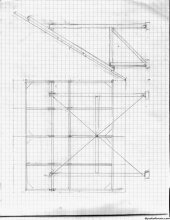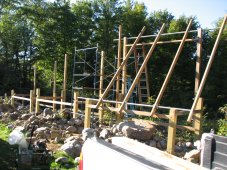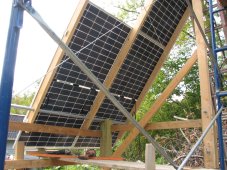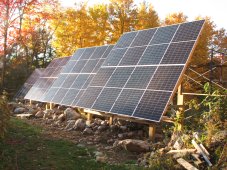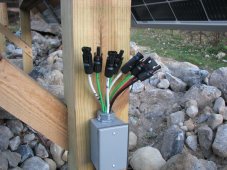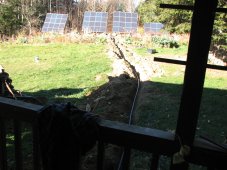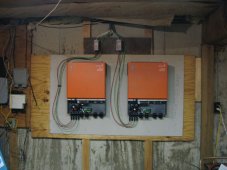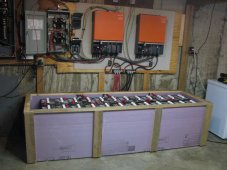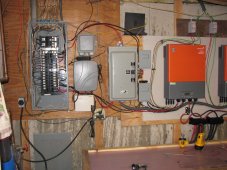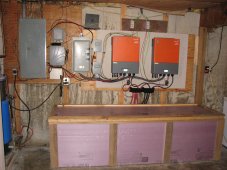Hi everyone, sorry I was gone for a few days.
OK first the racks aren't tiltable as they are but the bottom pole is only strapped onto the post and the upper one can act as a pivot, it could be made with some braces bolted to the post that could be swung up to support it if you figure a way to lift it. The poles I used are conduit and really not strong enough on their own to be the only support, you can see the weight of the panels bending them a little the panels lay on the wood bracing. I would recommend iron pipe, I built these myself by hand and it was a bit of a job so I opted for the lighter hoping to weasel out, I was able to muscle it and it worked. The posts are PT 6x6 about 4' in the ground which drains like a sieve so they will last forever and the rest is made from local hemlock and is pretty well protected from the elements, I have other structures of hemlock that get wet every time it rains and they have no rot after twenty five years so I was confident these would last my lifetime. I will attach the drawing I worked from. Honestly I have no interest in tilting, I have them at a 60° angle for the winter sun and the summer sun hits them with zero problem, I would assume you are about the same latitude, I'd rethink the need for tilting especially if you have as many panels, each one of these weighs about 500lbs.
Rocky soil for sure but I actually built it over a rock wall intentionally, it was the right place to put them and I figured that it would be easier to control weeds underneath, even with my big backhoe it was less easy than initially anticipated, I'd perhaps think about moving it back another ten feet if I did it again ha ha ha ha.
Thanks for the tip on the water. As I am thinking about it the conduit rises 20" up from the ground outside the foundation under a weathersafe porch I can make a bug safe drain hole in it and the water will exit there if it rises up. It is pretty well weather sealed so hope it doesn't get much often. Between running out of money and literally not being able to afford any more wire, and the fact it was the "supply chain breakdown" I had to drive over two hours in two directions to get 500' spools, as you can see I had to add onto the wires just to reach the inputs so I stretched it straight and had little wiggle room.
So here are the specs. 32 Canadian Solar 405W panels 48V, two Phocos PSW-H-6.5kW 120/48V AnyGrid inverters that have two inputs a piece that take 18A at 250V max and from what I understand they don't absorb overages well. So I have my panels wired in series of 4 running at 192V leaving lots of headroom for the -30° days where they may push V well into the 50s, I just couldn't take the risk with 5 plus the load works out perfectly for the inverters with a max of 18A @ 192V for each input, totaling 72A @ 192V for the entire array. It is the inverters you choose that will determine what wire you can run, I was originally looking at other inverters that took up to 600V DC in and going to run a couple big pairs over the distance but these inverters fit the bill better and required me to run 8 wires. I have the panels wired with 10 AWG from each series of four and concatenate them down to four 8 AWG pairs for the 150' run to the house. Running 8 to the panel sets would have been overkill and unnecessary as the 10 is well within the 2% loss specs for that application as is the 8 for the 150', it was cheaper too. I was a little worried about the 1"conduit fill with 8 wires but the pull was actually very easy. I ended up only putting breakers inside the house, putting more outside seemed superfluous.
My Battery bank is 24 6V 390Ah Crown lead acid batteries. Having been recently reminded that lead acid batteries can be renewed with my DC welder if they get sulfated which effectively makes them lifetime units I opted for the more environmentally friendly but higher maintenance instead of Li. They are wired as three 48V batteries with a combined capacity of 1040Ah which from the calculators I saw is around 56kWh. I have been watching the batteries charge even on rainy days, very encouraging. I will post some more pics soon as I will show you my hopefully innovative way to mitigate the cold basement which you are right to comment on. I am in the process of fitting a vent with a 48V fan that will go out the plate above like the wires, however the input to the very well insulated battery box will be a very well insulated pipe up to the ceiling of my living room about 10' away for the wood stove. Due to the fact that the Phocos has no relay connected to the charging circuit and I could not find that rumored relay that sensed the increase in charging voltage I figured that the only time it will be emitting gas is when the panels have light on them so I will instead use a timer and run the fan all day. Killing two birds with one stone it will draw 65° to 70° air through the bottom of the box under the batteries and then over top all day. I will monitor the temp inside the box and I can run the fan at night as well if I need to and it should keep the batteries as cozy as I can.
I am feeding my main panel backwards via a 60A breaker. I could not and would not set up a parallel or "critical" load panel, it makes no sense to me to not have a system that provides actual replacement of all the power I was using from the grid. I had a Mallard 100A transfer switch but no electrician would install it because I have a 200A box even though I have never used more than 80 on the outside ever. So I took that transfer switch and took out the busbars that connected the two switches to the main load bar, creating an isolation box that has two switches that cannot be turned on at the same time. If I need to externally charge the bank the AC in circuit is on one switch in case the grid is still on, and/or I can use my 220V plug in my garage as a generator backfeed. When I switch the transfer/isolation switch it disconnects the AC in and enables the AC out. The only risk I have is if someone were to flip the main breaker on while the inverters are on. I have it taped off and a sign that says DON'T TOUCH. I'm sure that is not considered code. I can always pull the meter if I think there is any real danger of that happening. Shhhh…
I have tried to be a safe as I possibly can or need to be. I went nuts on the neutral and ground bonding stuff isolating everything but my neutral from the grid was disconnected by the power company because I was getting almost 7 volts on it from the grid being "unbalanced" and my cow would not drink water with a heater in it. Apparently not that unusual in farm country. It is a ground just like the, uh, ground ha ha ha "pre-bonded? but things must be ok as my neutral is clean now.
I can not recommend people copy my stuff as I am a tinkerer and outlaw. I own my house outright and live in the boonies with little oversight. I've heard horror stories about permits and regulations etc that cost folks bundles. Keeping my fingers crossed on the quality and reliability of the Phocos units, the software seems slicker than some of its counterparts. Good luck to all and I hope your projects work out as well.
Thanks Bluedog, things are getting better

here's the drawing of the mounts, as you can see from the pictures I ad libbed more braces and put cables between the legs too, and as I said they are in the ground now no footings, they've withstood over 50mph winds so far and seem like they will handle the job. Poured footings pinned with rebar into the rock with a simpson tie post mount might work fine for you. Let me know if you need more info I have lots of pictures.
